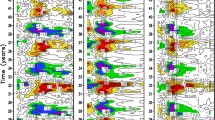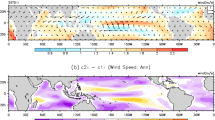Abstract
Freshwater flux (FWF) at the sea surface, defined as precipitation minus evaporation, is a major atmospheric forcing to the ocean that affects sea surface salinity (SSS) and buoyancy flux (QB). Physically, there exist two pathways through which interannual FWF variability can affect the ocean: one through SSS and the other through QB. The roles of the interannual FWF variability in modulating the El Niño-Southern Oscillation (ENSO) through its effects on SSS or QB are separately examined using a hybrid coupled model (HCM) of the tropical Pacific; its ocean component is a layer model in which the topmost layer (the first layer) is treated as a mixed layer (ML) whose depth (Hm) is explicitly predicted using an embedded bulk ML model with Hm being directly affected by QB, whereas in level ocean models, QB does not have a direct and explicit effect on Hm. Four experiments are conducted using the HCM that is designed to illustrate the effects of these processes on coupled simulations systematically. It is demonstrated that interannual FWF variability serves as a positive feedback on ENSO through its collective effects on both SSS and QB. Individually, the interannual FWF effect through SSS accounts for about 80% in terms of ENSO amplitude in the Niño 3.4 area, while that through buoyancy flux accounts for about 26%. This indicates that ocean models without explicitly taking into account the direct FWF effect on QB (typically in level ocean models) could underestimate the positive feedback on ENSO compared with layer ocean models in which the FWF effects are collectively represented on both SSS and QB. Further implications for model biases associated with FWF effects are discussed.
















Similar content being viewed by others
References
Bjerknes J (1969) Atmospheric teleconnections from the equatorial Pacific. Mon Weather Rev 97(3):163–172
Capotondi A, Wittenberg AT, Newman M et al (2015) Understanding ENSO diversity. Bull Am Meteor Soc 96(6):921–938
Chen D, Lian T, Fu C et al (2015) Strong influence of westerly wind bursts on El Niño diversity. Nat Geosci 8(5):339
Chen D, Rothstein LM, Busalacchi AJ (1994) A hybrid vertical mixing scheme and its application to tropical ocean models. J Phys Oceanogr 24(10):2156–2179
Cravatte S, Delcroix T, Zhang D et al (2009) Observed freshening and warming of the western Pacific warm pool. Clim Dyn 33(4):565–589
Delcroix T, Alory G, Cravatte S, Corrège T, McPhaden MJ (2011) A gridded sea surface salinity data set for the tropical Pacific with sample applications (1950–2008). Deep Sea Res Part I 58(1):38–48
Gent PR, Cane MA (1989) A reduced gravity, primitive equation model of the upper equatorial ocean. J Comput Phys 81(2):444–480
Kang X, Zhang RH (2017) Effects of different freshwater flux representations in an ocean general circulation model of the tropical Pacific. Sci Bull 62(5):345–351
Karnauskas KB, Busalacchi AJ (2009) Mechanisms for the interannual variability of SST in the east Pacific warm pool. J Clim 22(6):1375–1392
Karnauskas KB, Busalacchi AJ, Murtugudde R (2008) Low-frequency variability and remote forcing of gap winds over the east Pacific warm pool. J Clim 21(19):4901–4918
Kessler WS (1999) Interannual variability of the subsurface high salinity tongue south of the equator at 165 E. J Phys Oceanogr 29(8):2038–2049
Kraus EB, Turner JS (1967) A one-dimensional model of the seasonal thermocline II: The general theory and its consequences. Tellus 19(1):98–106
Large WG, McWilliams JC, Doney SC (1994) Oceanic vertical mixing: a review and a model with a nonlocal boundary layer parameterization. Rev Geophys 32(4):363–403
Latif M, Keenlyside NS (2009) El Niño/Southern Oscillation response to global warming. Proc Natl Acad Sci 106(49):20578–20583
Lumpkin R, Speer K (2007) Global ocean meridional overturning. J Phys Oceanogr 37(10):2550–2562
Lupton JE, Delaney JR, Johnson HP et al (1985) Entrainment and vertical transport of deep-ocean water by buoyant hydrothermal plumes. Nature 316(6029):621
Maes C, Picaut J, Belamari S (2002) Salinity barrier layer and onset of El Nino in a Pacific coupled model. Geophys Res Lett 29(24):1–4
Miller JR (1976) The salinity effect in a mixed layer ocean model. J Phys Oceanogr 6(1):29–35
Murtugudde R, Seager R, Busalacchi A (1996) Simulation of the tropical oceans with an ocean GCM coupled to an atmospheric mixed-layer model. J Clim 9(8):1795–1815
Price JF, Weller RA, Pinkel R (1986) Diurnal cycling: Observations and models of the upper ocean response to diurnal heating, cooling, and wind mixing. J Geophys Res Oceans 91(C7):8411–8427
Qu T, Song YT, Maes C (2014) Sea surface salinity and barrier layer variability in the equatorial Pacific as seen from Aquarius and Argo. J Geophys Res Oceans 119(1):15–29
Ren HL, Zuo J, Jin FF et al (2016) ENSO and annual cycle interaction: the combination mode representation in CMIP5 models. Clim Dyn 46(11–12):3753–3765
Seager R, Blumenthal MB, Kushnir Y (1995) An advective atmospheric mixed layer model for ocean modeling purposes: global simulation of surface heat fluxes. J Clim 8(8):1951–1964
Vialard J, Delecluse P (1998) An OGCM study for the TOGA decade. Part I: Role of salinity in the physics of the western Pacific fresh pool. J Phys Oceanogr 28(6):1071–1088
Vialard J, Delecluse P, Menkes C (2002) A modeling study of salinity variability and its effects in the tropical Pacific Ocean during the 1993–1999 period. J Geophys Res Oceans 107(C12):1–14
Waliser DE, Somerville RC (1994) Preferred latitudes of the intertropical convergence zone. J Atmos Sci 51(12):1619–1639
Willebrand J (1993) Forcing the ocean by heat and freshwater fluxes, energy and water cycles in the climate system. Springer, Berlin, pp 215–233
Wu L, Sun Y, Zhang J et al (2010) Coupled ocean–atmosphere response to idealized freshwater forcing over the western tropical Pacific. J Clim 23(7):1945–1954
Xie SP, Philander SG (1994) A coupled ocean-atmosphere model of relevance to the ITCZ in the eastern Pacific. Tellus A 46(4):340–350
Zhang RH (2015) Structure and effect of ocean biology-induced heating (OBH) in the tropical Pacific, diagnosed from a hybrid coupled model simulation. Clim Dyn 44(3–4):695–715
Zhang RH, Busalacchi AJ (2009a) Freshwater flux (FWF)-induced oceanic feedback in a hybrid coupled model of the tropical Pacific. J Clim 22(4):853–879
Zhang RH, Busalacchi AJ (2009b) An empirical model for surface wind stress response to SST forcing induced by tropical instability waves (TIWs) in the eastern equatorial Pacific. Mon Weather Rev 137(6):2021–2046
Zhang RH, Busalacchi AJ, Murtugudde RG (2006) Improving SST anomaly simulations in a layer ocean model with an embedded entrainment temperature submodel. J Clim 19(18):4638–4663
Zhang RH, Gao C (2016) The IOCAS intermediate coupled model (IOCAS ICM) and its real-time predictions of the 2015–2016 El Niño event. Sci Bull 61(13):1061–1070
Zhang RH, Gao C, Kang X et al (2015) ENSO modulations due to interannual variability of freshwater forcing and ocean biology-induced heating in the tropical Pacific. Sci Rep 5:18506
Zhang RH, Tian F, Busalacchi AJ et al (2019) Freshwater flux and ocean chlorophyll produce nonlinear feedbacks in the tropical Pacific. J Clim 32(7):2037–2055
Zhang RH, Zebiak SE (2002) Effect of penetrating momentum flux over the surface boundary/mixed layer in a z-coordinate OGCM of the tropical Pacific. J Phys Oceanogr 32(12):3616–3637
Zhang RH, Zebiak SE (2004) An embedding method for improving interannual variability simulations in a hybrid coupled model of the tropical Pacific ocean–atmosphere system. J Clim 17(14):2794–2812
Zhang RH, Zheng F, Zhu J et al (2012) Modulation of El Niño-Southern Oscillation by freshwater flux and salinity variability in the tropical Pacific. Adv Atmos Sci 29(4):647–660
Zheng F, Zhang RH (2015) Interannually varying salinity effects on ENSO in the tropical Pacific: a diagnostic analysis from Argo. Ocean Dyn 65(5):691–705
Zhi H, Zhang RH, Lin P et al (2015) Quantitative analysis of the feedback induced by the freshwater flux in the tropical Pacific using CMIP5. Adv Atmos Sci 32(10):1341–1353
Zhu J, Huang B, Zhang RH et al (2014) Salinity anomaly as a trigger for ENSO events. Sci Rep 4:6821
Zhu Y, Zhang RH (2018) Scaling wind stirring effects in an oceanic bulk mixed layer model with application to an OGCM of the tropical Pacific. Clim Dyn 51(5–6):1927–1946
Acknowledgements
The authors wish to thank the anonymous reviewers for their comments and suggestions that helped to improve the original manuscript. This research was supported by the National Key Research and Development Program of China (No. 2017YFC1404102(2017YFC1404100)), the National Natural Science Foundation of China (Grant Nos. 41705082, 41690122(41690120) and 41421005), the NSFC-Shandong Joint Fund for Marine Science Research Centers (U1406402), the Strategic Priority Research Program of the Chinese Academy of Sciences (Grant No. XDA19060102) and the Taishan Scholarship. All figures in the paper are created by the authors using the Grid Analysis and Display System (GrADS) which is available at https://www.iges.org/grads/grads.html.
Author information
Authors and Affiliations
Corresponding author
Additional information
Publisher's Note
Springer Nature remains neutral with regard to jurisdictional claims in published maps and institutional affiliations.
Rights and permissions
About this article
Cite this article
Gao, C., Zhang, RH., Karnauskas, K.B. et al. Separating freshwater flux effects on ENSO in a hybrid coupled model of the tropical Pacific. Clim Dyn 54, 4605–4626 (2020). https://doi.org/10.1007/s00382-020-05245-y
Received:
Accepted:
Published:
Issue Date:
DOI: https://doi.org/10.1007/s00382-020-05245-y




